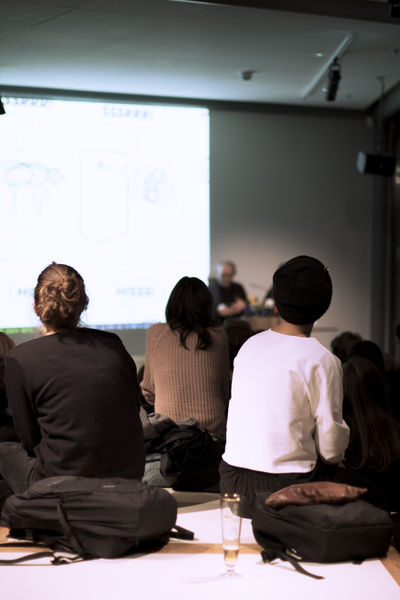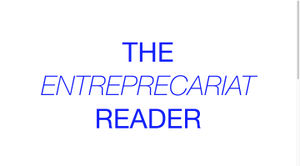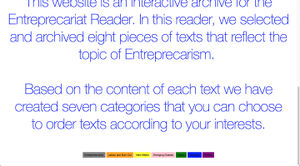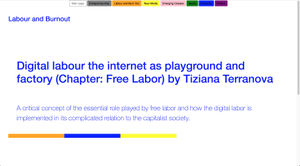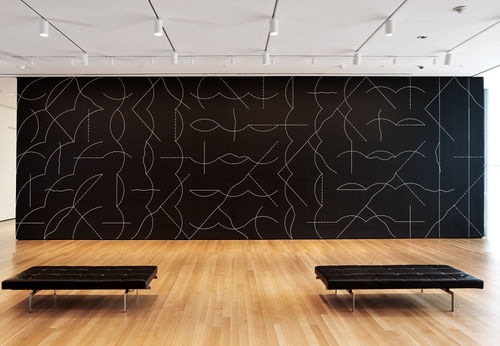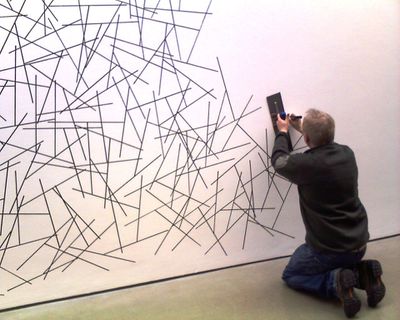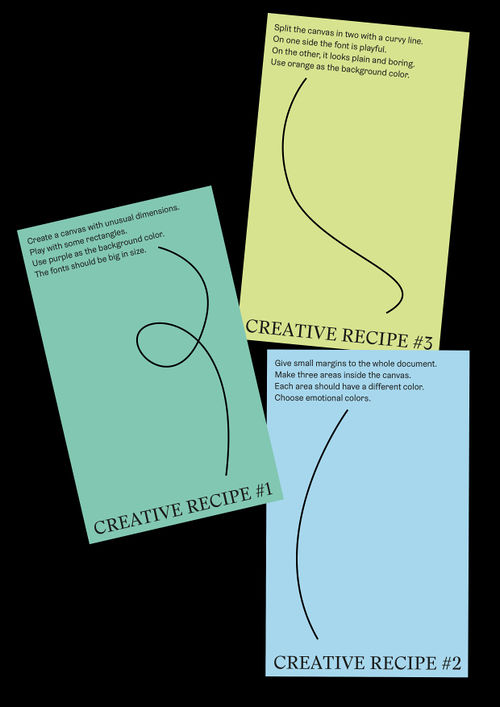User:Rita Graca/specialissue: Difference between revisions
Rita Graca (talk | contribs) No edit summary |
Rita Graca (talk | contribs) No edit summary |
||
| (37 intermediate revisions by the same user not shown) | |||
| Line 1: | Line 1: | ||
<big>'''START UP, BURN OUT: LIFE HACKS'''</big> | |||
== Events == | |||
=== Life Hacks: Space === | |||
[http://varia.zone/lifehacks.html Varia event] | |||
https:// | [[Progress pics for Varia Event| Progress pictures]] | ||
[[Special_Issue:_Life_Hacks#Ten_Theses_Archive|X Theses]] | |||
[[File:Xtheses.jpg|left|400px|X Theses]] | |||
<br clear=all> | |||
=== Life Hacks: Time === | |||
[https://burnout.hetnieuweinstituut.nl/en/activities/life-hacks-time Het Nieuwe Instituut event] | |||
[[File:lifehacks_time.jpg|left|400px|Time]] | |||
<br clear=all> | |||
=== Special Issue Launch === | |||
[https://burnout.hetnieuweinstituut.nl/en/activities/life-hacks-introducing-iris Het Nieuwe Instituut event] | |||
[https://git.xpub.nl/XPUB/si_7-IRIS IRIS, git files] | |||
[[Iris|IRIS, wiki page]] | |||
=== Life Hacks: Mind === | |||
[https://thursdaynight.hetnieuweinstituut.nl/en/activities/life-hacks-mind Het Nieuwe Instituut event] | |||
== Silvio's classes == | |||
=== WdKA tour === | |||
(w/ Bo) <br> | |||
http://pzwiki.wdka.nl/mediadesign/Bo_%26_Rita | |||
=== Suggestions and presentation === | |||
(w/ Bo and Pedro) <br> | |||
[[File:presentation_space.pdf|left|400px|pdf]] | |||
<br clear=all> | |||
==Steve's class== | |||
===What, Why, How=== | |||
[http://pzwiki.wdka.nl/mediadesign/Rita%27s_What_Why_How_26-9-18 "What How Why"] | |||
=== Entreprecariat Reader === | |||
(w/ Biyi, Tancredi, Bo) <br> | |||
[https://git.xpub.nl/rita/Entreprecariat_Reader All files in git] | |||
This website is an interactive archive for the Entreprecariat Reader. In this reader, we selected and archived eight pieces of texts that reflect the topic of Entreprecarism. <br> | |||
Based on the content of each text we have created seven categories that you can choose to order texts according to your interests. <br> | |||
These categories are: Entrepreneurship, Economy, Emerging Classes, Labour and Burnout, New Media, Politics and Space. | |||
[http://pzwiki.wdka.nl/mediadesign/Entreprecariat_reader_synopses_and_abstracts Entreprecariat — Synopses and Abstracts]<br> | |||
[[File:entreprecariat_reader0.jpg|300px|screenshot 1]] | |||
[[File:entreprecariat_reader1.jpg|300px|screenshot 2]] | |||
[[File:Entreprecariat reader2.jpg|300px|screenshot 3]] | |||
=== Personal Assignment === | |||
Synopsis on: <br> | |||
Kenneth Goldsmith. ''Uncreative Writing: Managing Language in the Digital Age.'' <br> | |||
''Chapter 6: Infallible Processes. What Writing Can Learn from Visual Art'' | |||
In the chapter ''Infallible Processes: What Writing Can Learn from Visual Art'', Goldsmith makes an interesting parallelism between conceptual art and writing, looking at uncreativity as an acceptable starting point to create and increase creativity. The author gives as examples artists like LeWitt, Duchamp and Andy Warhol, whose works seen out of context may seem quite mundane. These artists praised the process of their creation instead of the final product. Their conceptual works strength the idea of an artist as an intellectual because they don’t rely on their skills as craftsmen. Consequently, they take the sacredness away from the artwork as you don’t need to be gifted as an artisan and they challenge the notion of authorship. Indeed, LeWitt created general guidelines that would be executed in posteriority by draftsmen. An example of a set of rules is: “Wall Drawing 852: A wall divided from the upper left to the lower right by a curvy line; left: glossy yellow; right: glossy purple.” | |||
Although constricted by the recipe, the draftsmen have to make choices and therefore they are also being creators. Even if the recipe is followed by other people the problem of originality it’s not important because the outcome will always be different. <br /> | |||
The author uses the mindset of the conceptual artists of the 20th century to illustrate how apparent uninteresting processes can lead to inspiration and help to face with less horror the start of a new piece. | |||
[[File:Lewitt.jpg|500px | Wall drawing]] | |||
[[File:Lewitt2.jpg | 400 px | Wall drawing 2]] | |||
'''Task: make some graphic design recipes, initial tests''' | |||
1. Create a canvas with unusual dimensions. <br> | |||
Play with some rectangles.<br> | |||
Use purple as the background color.<br> | |||
The fonts should be big in size.<br> | |||
2. Give small margins to the whole document.<br> | |||
Make three areas inside the canvas.<br> | |||
Each area should have a different color. <br> | |||
Choose emotional colors.<br> | |||
3. Split the canvas in two with a curvy line.<br> | |||
On one side the font is playful. <br> | |||
On the other, it looks plain and boring. <br> | |||
Use orange as the background color.<br> | |||
[[File:Creative recipe.jpg|500px |]] | |||
== Notes == | |||
The idea of the Entreprecariat has been popularised following the 2008 crisis. | The idea of the Entreprecariat has been popularised following the 2008 crisis. | ||
| Line 49: | Line 117: | ||
An insecure class. | An insecure class. | ||
Its growth has been accelerated by the neoliberalism of | Its growth has been accelerated by the neoliberalism of globalization, which put faith in labour market flexibility, the commodification of everything and the restructuring of social protection. | ||
[[File:Sad entrepecariat.jpg|400px|left|timberland_poster]] | |||
<br clear=all> | |||
== Pads == | |||
https://pad.xpub.nl/p/burnout-02.10.18<br /> | |||
https://pad.xpub.nl/p/burnout-18.09.18 | |||
[[Category: Start up, Burn out: Life Hacks]] | [[Category: Start up, Burn out: Life Hacks]] | ||
Latest revision as of 11:39, 20 May 2020
START UP, BURN OUT: LIFE HACKS
Events
Life Hacks: Space
Life Hacks: Time
Special Issue Launch
Life Hacks: Mind
Silvio's classes
WdKA tour
(w/ Bo)
http://pzwiki.wdka.nl/mediadesign/Bo_%26_Rita
Suggestions and presentation
(w/ Bo and Pedro)
File:Presentation space.pdf
Steve's class
What, Why, How
Entreprecariat Reader
(w/ Biyi, Tancredi, Bo)
All files in git
This website is an interactive archive for the Entreprecariat Reader. In this reader, we selected and archived eight pieces of texts that reflect the topic of Entreprecarism.
Based on the content of each text we have created seven categories that you can choose to order texts according to your interests.
These categories are: Entrepreneurship, Economy, Emerging Classes, Labour and Burnout, New Media, Politics and Space.
Entreprecariat — Synopses and Abstracts
Personal Assignment
Synopsis on:
Kenneth Goldsmith. Uncreative Writing: Managing Language in the Digital Age.
Chapter 6: Infallible Processes. What Writing Can Learn from Visual Art
In the chapter Infallible Processes: What Writing Can Learn from Visual Art, Goldsmith makes an interesting parallelism between conceptual art and writing, looking at uncreativity as an acceptable starting point to create and increase creativity. The author gives as examples artists like LeWitt, Duchamp and Andy Warhol, whose works seen out of context may seem quite mundane. These artists praised the process of their creation instead of the final product. Their conceptual works strength the idea of an artist as an intellectual because they don’t rely on their skills as craftsmen. Consequently, they take the sacredness away from the artwork as you don’t need to be gifted as an artisan and they challenge the notion of authorship. Indeed, LeWitt created general guidelines that would be executed in posteriority by draftsmen. An example of a set of rules is: “Wall Drawing 852: A wall divided from the upper left to the lower right by a curvy line; left: glossy yellow; right: glossy purple.”
Although constricted by the recipe, the draftsmen have to make choices and therefore they are also being creators. Even if the recipe is followed by other people the problem of originality it’s not important because the outcome will always be different.
The author uses the mindset of the conceptual artists of the 20th century to illustrate how apparent uninteresting processes can lead to inspiration and help to face with less horror the start of a new piece.
Task: make some graphic design recipes, initial tests
1. Create a canvas with unusual dimensions.
Play with some rectangles.
Use purple as the background color.
The fonts should be big in size.
2. Give small margins to the whole document.
Make three areas inside the canvas.
Each area should have a different color.
Choose emotional colors.
3. Split the canvas in two with a curvy line.
On one side the font is playful.
On the other, it looks plain and boring.
Use orange as the background color.
Notes
The idea of the Entreprecariat has been popularised following the 2008 crisis.
Gig Economy — Corporations set up their business model in such a way that they have a minimum number of formal employees, while ‘engaging services’ from a large pool of casualized, self-employed people.
According to the New York Times Crossword Puzzle, "the precariat is the class of people whose lives are precarious because they have little or no job security".
“Worker rights in online labour platforms should be of interest for anyone concerned with the present and future of democracy”
Why do companies want to make contracts where they state the person is “self-employed”? The benefits are that they don’t owe them anything. It ensures they have no employment rights of any kind.
What is the breach in the law that allows them to not pay the minimum wage to their workers? Is the “self-employed” title?
With most platforms classifying their workers as independent contractors, the platforms have freed themselves from the responsibilities that employers have in complying with labour rights, including basic protections such as paying the minimum wage, respecting limitations on working hours, providing paid sick leave, making social security contributions, and permitting collective bargaining. And in the process, working conditions and earnings have suffered.
“A new precarious class has superseded the old working class: the service precariat of the 21st century, the analogue of the industrial proletariat of the 20th century; the precarious are organizing in the workplace, in the streets, and on the net, developing a distinctively anarcho-populist ideology and an eco-queer culture.”
An insecure class. Its growth has been accelerated by the neoliberalism of globalization, which put faith in labour market flexibility, the commodification of everything and the restructuring of social protection.
Pads
https://pad.xpub.nl/p/burnout-02.10.18
https://pad.xpub.nl/p/burnout-18.09.18


